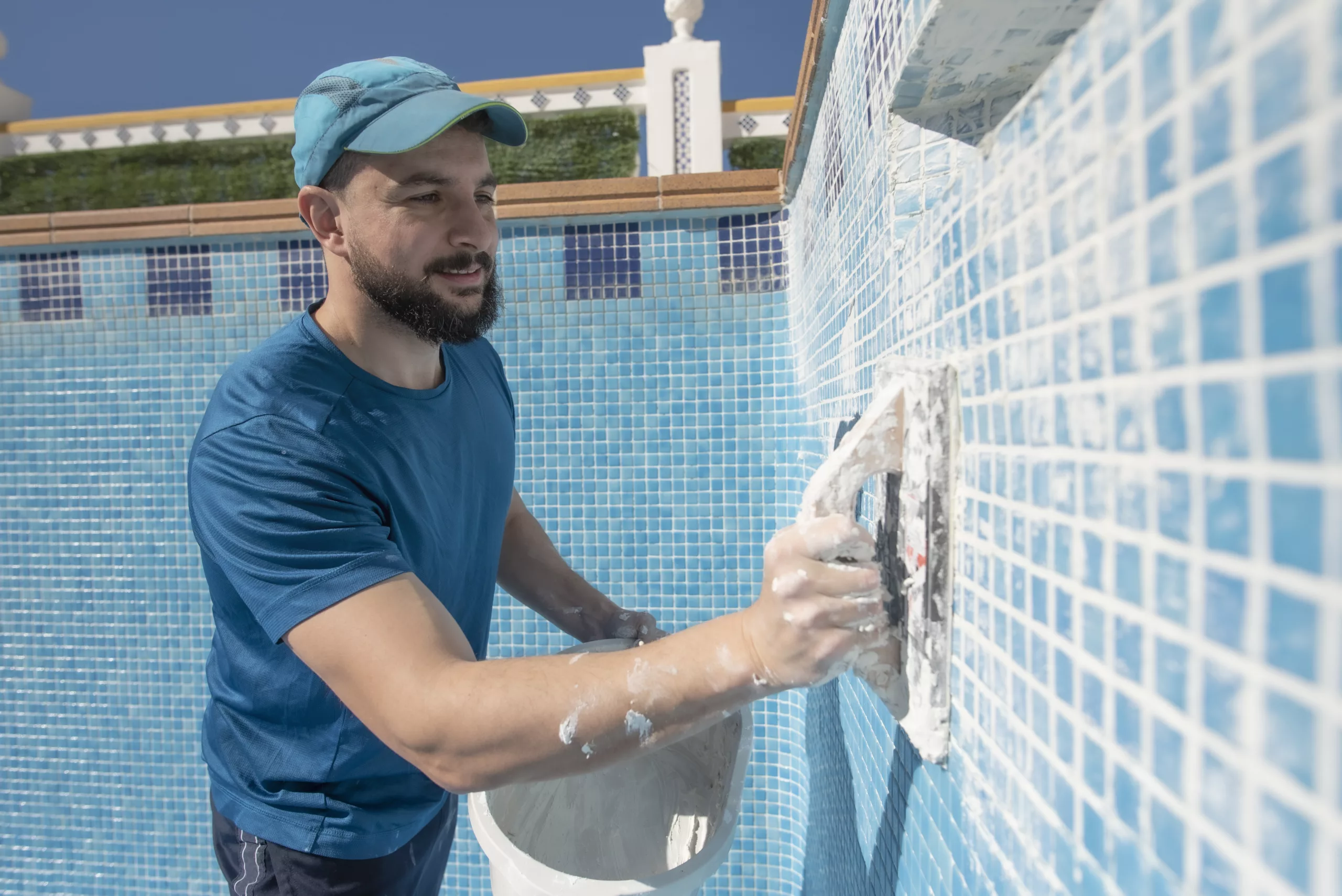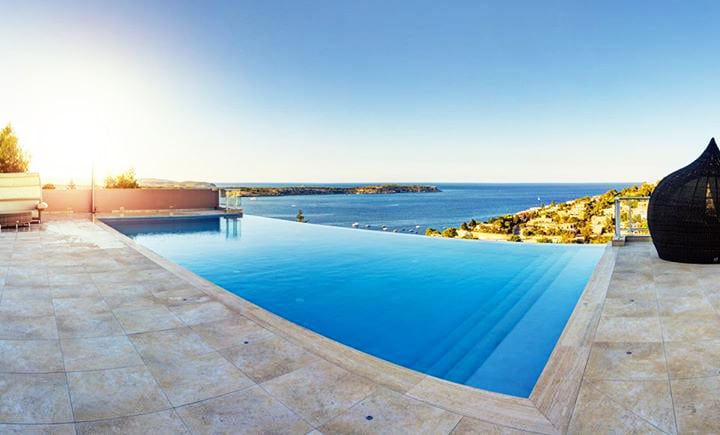The Ultimate Guide to Choosing and Using Pool Sealers: Everything You Need to Know

Sealing a pool deck can feel like a big puzzle with all the different options. Did you know the right pool sealers can extend your pool area’s life and beauty? This guide will show you how to pick and apply the perfect sealant for a watertight, stunning poolside.
Key Takeaways
- Different types of pool sealers, including epoxy putty and liquid rubber, are designed for specific issues like cracks or waterproofing. Choose the one that fits your pool’s material and needs.
- Before applying any sealer, clean and dry the surface thoroughly to ensure it sticks well. Follow the manufacturer’s instructions for best results.
- Reapply pool sealants every 1-3 years, but check regularly for signs of wear. This keeps your pool area protected from damage and looking good.
- Use trusted brands known for quality when selecting a sealer. Look for products with UV resistance and slip-resistant finishes for added safety around the pool deck.
- Prepare properly by cleaning surfaces and using the right tools, like rollers or brushes, to apply sealers evenly without oversaturation for effective maintenance.
Types of Pool Sealers
There are several types of pool sealers available, including epoxy putty, liquid rubber, all-purpose primer, fabric, clear coat & sealer, and fountain sealer. Each type has its own unique properties and uses for waterproofing and protecting your pool deck or coping.
Epoxy Putty
Epoxy putty stands out as a robust option for sealing cracks and leaks in swimming pools. It’s a two-part adhesive known for its strong bonding capabilities, making it ideal for underwater pool maintenance and concrete sealing around pool water.
Users can apply epoxy putty to damp surfaces, which is perfect for quick fixes without draining the entire pool. Its versatile nature ensures that it adheres well not only to concrete but also to fiberglass, metal, and plastic components of the pool structure.
Moldable before curing, epoxy putty allows precise application on irregular shapes or surfaces where liquid sealants might be impractical. It provides surface protection by creating a waterproof barrier that withstands constant exposure to chlorine and other chemicals found in swimming pools.
Pool care guides often suggest this sealer when addressing immediate repair needs due to its rapid set time and long-lasting durability even under challenging conditions such as saltwater pools.
Liquid Rubber
When considering pool sealers, liquid rubber stands out as a versatile option that provides superior waterproofing and protection for various pool surfaces. Liquid rubber sealants offer excellent adhesion to both wet and dry surfaces, making them ideal for sealing joints in swimming pool coping, decks, and other porous materials.
The elastic properties of liquid rubber enable it to flex with the substrate, ensuring long-lasting durability and resistance to cracking or peeling. This makes it an excellent choice for maintaining the integrity of concrete around pools.
Liquid rubber offers exceptional water resistance, making it suitable for use in both saltwater and chlorine-treated pools. Its seamless application creates a barrier against moisture penetration while providing UV stability for prolonged exposure to sunlight.
All-Purpose Primer
An all-purpose primer serves as a versatile option for sealing pool decks and coping materials. It provides a solid base for various types of sealants, ensuring proper adhesion and durability.
This type of primer can be used on different surfaces such as concrete, pavers, and flagstone coping, offering excellent waterproofing and protection against stains and damage. When selecting an all-purpose primer, it is essential to consider its compatibility with the specific sealant being applied and its ability to enhance the overall performance of the sealant in maintaining the integrity of pool surfaces.
When using an all-purpose primer, it’s crucial to follow the manufacturer’s guidelines for application techniques to ensure optimal results. Applying this primer before using other sealants can significantly improve their effectiveness in preserving and beautifying pool decks while providing long-lasting protection from environmental elements.
Fabric
When transitioning from all-purpose primer to fabric sealers, it’s essential to consider the unique benefits that fabric sealers offer for pool maintenance. Fabric sealers are particularly effective for waterproofing and protecting porous surfaces such as flagstone coping and pavers around the pool deck.
Unlike other types of sealants, fabric sealers provide a flexible and breathable protective barrier, allowing moisture to escape while preventing water ingress. This type of sealer is ideal for enhancing the longevity of pool coping materials and ensuring their resistance to stains and damage in various weather conditions.

Clear Coat & Sealer
When considering pool sealers, clear coat and sealer play a crucial role in offering protection while maintaining the aesthetic appeal of the pool surface. The clear coat acts as a barrier against stains and damage, ensuring that the pool deck remains slip-free and visually appealing.
By using a high-quality clear coat and sealer, pool owners can safeguard their concrete from harsh environmental elements, create a waterproof barrier to prevent water damage, and enhance the longevity of the pool deck.
Additionally, these products provide an added layer of UV protection to maintain the color integrity of the concrete or pavers.
Fountain Sealer
When it comes to sealing fountains, the right sealer can protect against water damage and enhance the overall appearance. Selecting a high-quality fountain sealer is crucial for maintaining the integrity of materials used in constructing fountains such as concrete, stone, or ceramic.
Waterproofing pool deck and fountain surfaces requires sealants specifically designed for outdoor use and exposure to water. Using a suitable fountain sealer not only safeguards against cracking and discoloration caused by moisture but also extends the lifespan of your fountain.
Fountain sealer plays a vital role in preserving the aesthetic appeal of your outdoor water features by preventing efflorescence, mold growth, and mineral deposits. Properly sealed fountains are easier to clean and maintain while retaining their natural beauty.
How to Choose and Use Pool Sealers
To choose and use pool sealers effectively, it is important to first determine the type of sealer needed based on the specific needs of the pool area. Proper application techniques and tips for using pool sealers are also essential for long-lasting results.
Additionally, understanding how often to reapply sealer and being aware of recommended brands and products can help ensure the best outcome for maintaining a well-sealed pool area.
Determine the Type of Pool Sealer Needed
To select the right pool sealer, consider factors such as the material being sealed, whether it’s a concrete pool deck or pool coping. Also, take into account specific requirements like waterproofing, decorative finish, and slip resistance.
Understanding these needs will help in choosing between epoxy putty, liquid rubber, all-purpose primer, fabric sealers or clear coat & sealers for different areas around the pool.
Evaluate the level of protection required for your swimming pool and its surroundings to identify which type of pool sealer is most suitable for your specific maintenance needs. Take note that different types of sealants offer distinct benefits such as enhanced appearance, durability against stains and damage prevention.
Proper Application Techniques
When applying pool sealers, it is crucial to start with a clean and dry surface. Begin by thoroughly cleaning the area to remove dirt, debris, and any existing sealants using a suitable cleaner or detergent.
Ensure that the surface is completely dry before applying the new sealer to achieve optimal adhesion. Use a roller or brush to apply an even coat of the chosen pool sealer, following the manufacturer’s instructions for best results.
Take care not to oversaturate the surface, as this can lead to uneven application and longer drying times.
Applying pool sealers correctly is essential for ensuring effective protection and maintenance. Properly preparing and applying sealers in accordance with product guidelines helps maximize their performance and longevity while safeguarding your pool area from potential damage or wear.
How Often to Reapply Pool Sealers
To maintain the effectiveness of the pool sealer, it’s important to reapply it every 1-3 years. The frequency of reapplication depends on factors such as weather conditions, usage, and the type of sealer used.
Regular inspection and testing can help determine when a new coat is needed for optimal protection.
Understanding how often to reapply pool sealer ensures long-term durability and performance. By following these guidelines, you can preserve your pool surfaces effectively while reducing maintenance costs.
Tips for Using Pool Sealers Effectively
When applying pool sealers, ensure that the surface is thoroughly cleaned and free of debris to promote proper adhesion. It’s important to follow the manufacturer’s instructions for application and drying times to achieve optimal results.
Additionally, consider reapplying sealant as recommended to maintain a protective barrier against water, stains, and damage.
Choosing the right pool sealer can make all the difference in preserving your pool deck or coping materials. By selecting high-quality products suited for specific applications and following proper maintenance guidelines, you can prolong the lifespan of your pool surfaces and keep them looking their best.
Understanding how different sealants work allows you to make informed decisions when choosing and applying them.
Conclusion
Mastering the art of choosing and using pool sealers is crucial for maintaining a pristine swimming pool. Selecting the right sealant, following proper application techniques, and consistent maintenance are key to safeguarding your pool’s longevity.
With an array of options available, understanding your specific needs will ensure you make informed decisions when it comes to protecting your pool deck or coping from wear and tear.
An all-encompassing guide like this equips you with the knowledge needed to confidently select and apply the ideal pool sealer for your unique requirements.
For those thinking about the finish of their pool, consider ecoFINISH coatings. These cutting-edge pool finishes are designed to waterproof and protect, and they’re super smooth. Elevate your pool maintenance strategy with ecoFINISH’s durable and innovative aquatic coatings.

FAQs
1. What does a swimming pool sealer do?
A swimming pool sealer protects your pool deck from water damage, makes it slip-resistant, and keeps it looking new by sealing the concrete around the pool area.
2. Can I use any type of sealer on my concrete pool deck?
No, you should choose a concrete sealant specifically designed for saltwater pools if applicable or a decorative concrete sealer that best fits your needs for protection and appearance.
3. How often should I seal my swimming pool deck?
It’s important to apply a fresh layer of sealant to your pool deck every few years or as recommended by the sealant manufacturer to maintain proper deck protection and waterproofing.
4. Are there special types of sealers for different parts of my pool area?
Yes, besides general swimming pool sealants, there are specific products like sealant for pool coping and joint filler designed to keep every part of your pool area safe and well-maintained.
5. Is it easy to apply concrete sealing for pools myself?
Applying concrete sealer can be straightforward if you follow instructions; however, consider using professional services for an even application process of slip-resistant or waterproofing products.
